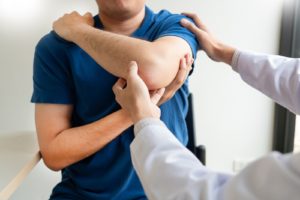Shoulder Instability Treatment in Arlington, VA
The shoulder is a highly moveable joint that allows the arm to lift and rotate. Along with its wide range of motion, however, comes inherent instability. A common cause of shoulder instability is an injury known as shoulder dislocation.
What Is Shoulder Dislocation and How Does This Injury Occur?
 Shoulder dislocation occurs when the head of the upper arm bone (humerus) does not stay properly centered within its socket (glenoid). This injury can result from sudden trauma or repetitive overhead motion, especially if the muscles and ligaments that support the shoulder joint are weak. Once dislocation occurs, the shoulder becomes more susceptible to repeat dislocations. Chronic shoulder instability develops when the ligaments, tendons and muscles around the shoulder loosen to the point that the humerus repeatedly slips out of place.
Shoulder dislocation occurs when the head of the upper arm bone (humerus) does not stay properly centered within its socket (glenoid). This injury can result from sudden trauma or repetitive overhead motion, especially if the muscles and ligaments that support the shoulder joint are weak. Once dislocation occurs, the shoulder becomes more susceptible to repeat dislocations. Chronic shoulder instability develops when the ligaments, tendons and muscles around the shoulder loosen to the point that the humerus repeatedly slips out of place.
Shoulder dislocation can be partial, in which the ball of the humerus comes partially out of its socket (subluxates), or complete, in which the ball of the humerus comes completely out of the socket. The ligaments at the front of the shoulder are often injured as well, and the cartilage rim around the edge of the glenoid (labrum) may also tear (an injury known as a Bankart lesion).
Treatment Options for Chronic Shoulder Instability
In most cases, treatment for chronic shoulder instability begins conservatively with:
- Lifestyle modifications – Activities that involve reaching overhead and movements that aggravate the pain and other symptoms should be avoided.
- Medications – Pain relievers and nonsteroidal anti-inflammatory drugs (NSAIDs) can help reduce painful swelling.
- Physical therapy – A physician or physical therapist can suggest appropriate exercises to strengthen the rotator cuff muscles that support the shoulder.
Surgery may be considered to address severely stretched or torn ligaments and improve their ability to hold the shoulder bones firmly in place. If a Bankart lesion is present, it may be repaired with sutures to re-anchor the torn piece of cartilage to the bone. After surgery, the patient may wear a sling to temporarily immobilize the shoulder as it heals. Then, once the doctor approves, the patient can start a physical therapy program to enhance the range of motion in the shoulder and gradually strengthen the muscles that support it.
If you’re experiencing symptoms of shoulder instability, you can feel confident entrusting your care to the Nirschl Orthopaedic Group in Arlington, VA. Contact us today at (703) 525-2200 to request an appointment with a shoulder specialist who can promptly evaluate your shoulder pain and help you determine if conservative or surgical treatment is appropriate.
